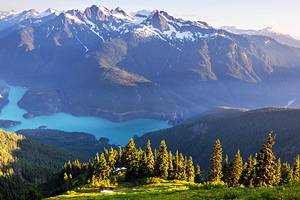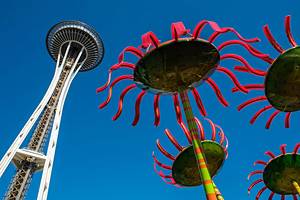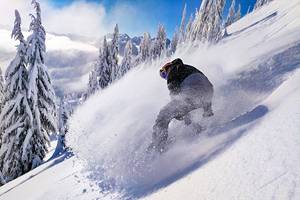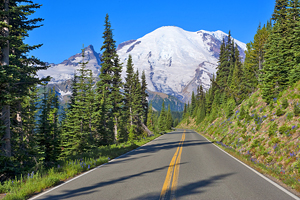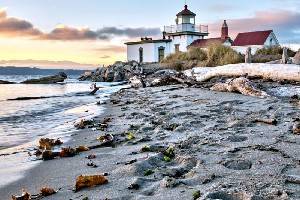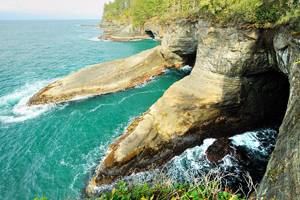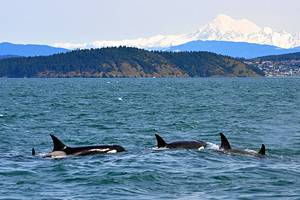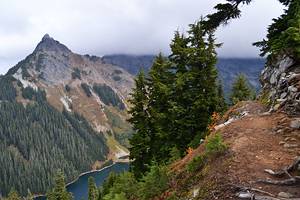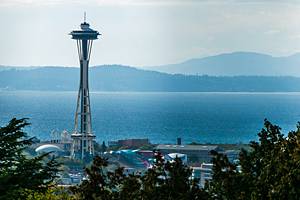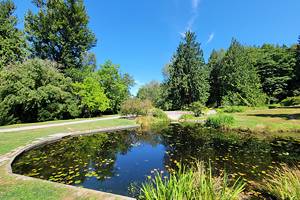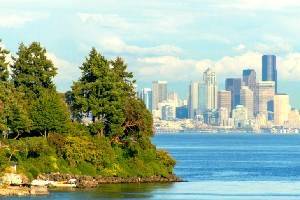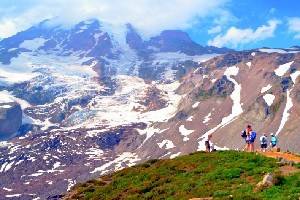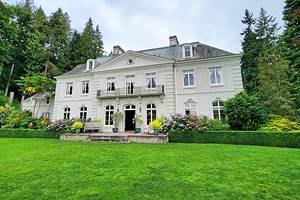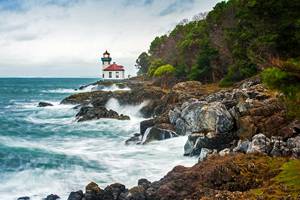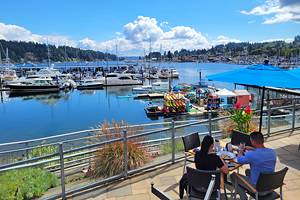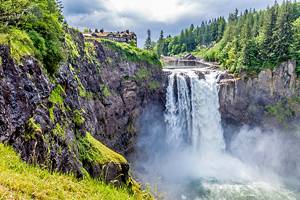From Seattle to Olympic National Park: Ways to Get There
Author Brad Lane lives in the Pacific Northwest and has traveled from Seattle to Olympic National Park many times. Most recently he utilized trailhead shuttle services on a backpacking trip through the Seven Lakes Basin.
Several options exist to travel from Seattle to Olympic National Park. Visitors reach the rugged landscapes of the Olympic Peninsula from Seattle by car, ferry, transfer service, or public bus line. Organized tours of Olympic National Park are also available that leave the trip planning to a knowledgeable guide.

The National Park Visitor Center is a recommended first place to go when visiting Olympic, located in Port Angeles, on the north side of the peninsula. It's approximately an 80-mile drive from Seattle to the visitor center, including a ferry ride. The Straight Shot bus line from Clallam Transit provides a direct service to Port Angeles from Seattle with a three-hour route. Visitors from Seattle can also arrange a shuttle to the visitor center.
Port Angeles isn't the only city that accesses Olympic National Park, not by a long shot. Other destinations with quick access to the park include Sequim, Forks, La Push, Queets, and Quinault. All these cities and towns are on Highway 101—the only road circling the entire park.
The density of the rainforests and the rugged nature of the Olympic Mountains denies any road access through the middle of the park. Instead, Highway 101 circles the Olympic Peninsula and is the main roadway that connects different regions of the park. Several public bus lines run the entirety of Highway 101, making it easy to get around once you've made it to the Olympic Peninsula.
On This Page:
From Seattle to Olympic National Park by Organized Tour

The easiest way to explore Olympic National Park from Seattle is by joining an Olympic National Park day tour from Seattle.
With a knowledgeable guide behind the wheel, this organized tour is also the best way to experience the depths of the Olympic Peninsula in a short amount of time.
Riding in a seven-seat SUV, minivan, or motor coach (depending on the number of guests), this 8- to 10-hour tour takes you to the most scenic parts of the park.
The itinerary can be adjusted to account for adverse weather and conditions. Typically, though, it passes by Olympic National Park Visitor Centre and stops at the mountainous region of Hurricane Ridge, the highest area of the park that is accessible by car. It's a popular spot for hiking, skiing, snowboarding, and summer picnics.
Next the tour continues to Lake Crescent, a beautiful bright-blue lake in the heart of Olympic National Park.
Finally, the tours lingers at the Scandinavian-style town of Poulsbo in Kitapp County, known as Washington's Little Norway. Enjoy time to browse the quaint gift shops, galleries, and handicraft stores, and sample local chocolate, coffee, and bread before returning to Seattle.
From Seattle to Olympic National Park by Ferry

Traveling to Olympic National Park from Seattle is most often accomplished by taking a ferry across Puget Sound. A ferry is especially convenient for going to the northeast side of the park, including Port Angeles and Port Townsend.
Visitors take their personal vehicle to the Seattle Ferry Terminal downtown and drive onto the ferry. Public transportation is also available to the ferry terminal, and passengers can buy walk-on tickets to ride.
The two most common ferries to take from Seattle to Olympic National Park are the Bainbridge Island ferry, operated by WSDOT, and the Kingston Fast Ferry operated by Kitsap Transit. For those in the northern part of the city, the Edmonds-Kingston ferry is a third option to reach the Kitsap Peninsula.
The Bainbridge Island and Edmonds-Kingston ferries allow passengers to stow their vehicles below deck and portage them across Puget Sound. The Kingston Fast Ferry is for walk-on passengers only. For those riding the Fast Ferry, personal vehicles need to stay parked at the ferry terminal. The Fast Ferry service only takes 40 minutes to travel from Seattle to Kingston.
From Bainbridge Island, it's a 70-mile drive to Port Angeles and the Olympic National Park Visitor Center. Bainbridge Island is a postcard-worthy destination itself for those interested in side trips.
It's slightly less money but nearly the same distance to Port Angeles from Kingston, with fewer public transportation options. It requires three transfers to reach Port Angeles from Kingston by bus, including transfers in Port Townsend and Sequim. A shuttle service is also available between Kingston and the northern peninsula (see: Seattle to Olympic National Park by Transfer Service).
Public transportation to Port Angeles also passes through Bainbridge Island. Route 123, also known as "The Straight Shot," offers a three-hour bus ride from Seattle to Port Angeles, which includes a ferry ride. Clallam Transit operates the service. More information on public transportation options are below (see: Seattle to Olympic National Park by Bus).
From Seattle to Olympic National Park by Car

If boarding a ferry doesn't sound pleasing, it's possible to drive onto the Olympic Peninsula without driving onto a boat. For destinations on the southwest side of the Olympic Peninsula, including the Quinault Rain Forest, a ferry isn't even the best way to go. Last-minute trips might also want to avoid the ferry because the boats sell out of vehicle space.
The entirety of Olympic National Park is accessible without a ferry ride. South of Seattle, several state highways branch off Interstate 5 and access the Olympic Peninsula. The most common first step for driving to Olympic from Seattle is hopping on I-5 South to exit the city.
Thirty miles south on I-5 in Tacoma, State Route 16 accesses Bremerton on the Kitsap Peninsula with a 40-minute drive. It's approximately 100 miles from Bremerton to places like Port Angeles on the north side of the park. The route passes over the Hood Canal Floating Bridge on State Route 104, which closes periodically for boat traffic. Visitors heading to the peninsula from Tacoma and State Route 16 should check the bridge status before departing.
Farther south on I-5 from Seattle, visitors can also reach Olympic National Park from the state capital of Olympia. Visitors from Olympia access Highway 101, the only road that circles the park. Cities like Hoodsport on the east side of the park are accessible within an hour's drive from Olympia. The southwest side of the park, including Quinault and Queets, is reachable from Olympia in a two-hour drive.
Much of the park is accessible with a combination of public transportation and private charters. However, having a vehicle ensures the greatest access to tucked-away trailheads and off-the-beaten-path adventures. Some forest roads in the interior of the park may require four-wheel drive or high-clearance vehicles. Be sure to check your gas tank level before venturing too deep.
From Seattle to Olympic National Park by Transfer Service

Rocket Transportation is one of the only available transfer services from Seattle to Olympic National Park. This shuttle company operates out of Sequim and provides service between King County and the Olympic Peninsula. The shuttle service does not drop off hikers in the park. Instead, Rocket Transportation offers door-to-door service to communities on the Olympic Peninsula.
Rocket Transportation picks up travelers in King County, Pierce County, and SeaTac International Airport. The base area for passenger delivery extends as far west as Port Angeles and includes Port Townsend, Port Haddock, and Sequim. These destinations on the Olympic Peninsula feature the lowest fares for transfer service.
Rocket Transportation also delivers visitors to outlying areas like Lake Crescent Lodge or the town of Forks. Rides from Rocket Transportation are by reservation only. After taking the transfer service to the Olympic Peninsula, passengers can use public bus routes to navigate Highway 101.
Upon making it to the Peninsula, Olympic Hiking Company offers transfer service to different trailheads. These shuttle rides are available throughout the extended summer season and are ideal for those interested in point-to-point backpacking within the park. Many of the shuttles deliver hikers up and down the Wilderness Coast. Transportation service between the Sol Duc Valley and Hoh Rainforest is also available.
From Seattle to Olympic National Park by Bus

Tourists have several options for boarding a bus to Olympic National Park, and several bus options upon making it to the Peninsula. Going by bus takes the longest, but with options like the Straight Shot from Clallam Transit, the journey can take as little as three hours. And, for those traveling without a car, bus lines on the peninsula offer a valuable resource for getting around upon arrival.
Three prominent bus lines depart Seattle and access the Olympic Peninsula. The Dungeness Line from Olympic Bus Lines offers service from SeaTac to Port Angeles with many stops along the way. The Dungeness Line operates two trips in either direction every day. The entire route takes under five hours to complete.
Greyhound buses also deliver passengers from Seattle to destinations on the Olympic Peninsula like Port Angeles. The greyhound route travels north out of the city and reaches the Kitsap Peninsula on the Edmonds-Kingston ferry. Greyhound buses also takes between four and five hours to reach the Olympic Peninsula.
Clallam Transit offers a similar service to the north side of the Olympic Peninsula. The Straight Shot (Route 123), from Clallam Transit, delivers passengers to Port Angeles from Seattle in under three hours. The route includes a ferry ride to Bainbridge Island. Clallam Transit also operates over a dozen local routes that service the Olympic Peninsula and extend as far west as La Push and Neah Bay.
On the Olympic Peninsula, additional public bus routes cover every mile of Highway 101 that surrounds the park. Jefferson Transit operates on the eastern side of the park and includes bus stops in Port Townsend. Jefferson Transit also runs a vital Olympic Connection line on the west side of the park that connects Forks to Quinault.
Grays Harbor Transit services the southwest side of the park, including routes that connect Olympia to Lake Quinault. For those trying to reach the Quinault Rain Forest by public transportation, Grays Harbor Transit is the service to catch after taking a bus from Seattle to Olympia. Grays Harbor Transit also features routes on the Washington coast surrounding both sides of Grays Harbor.


